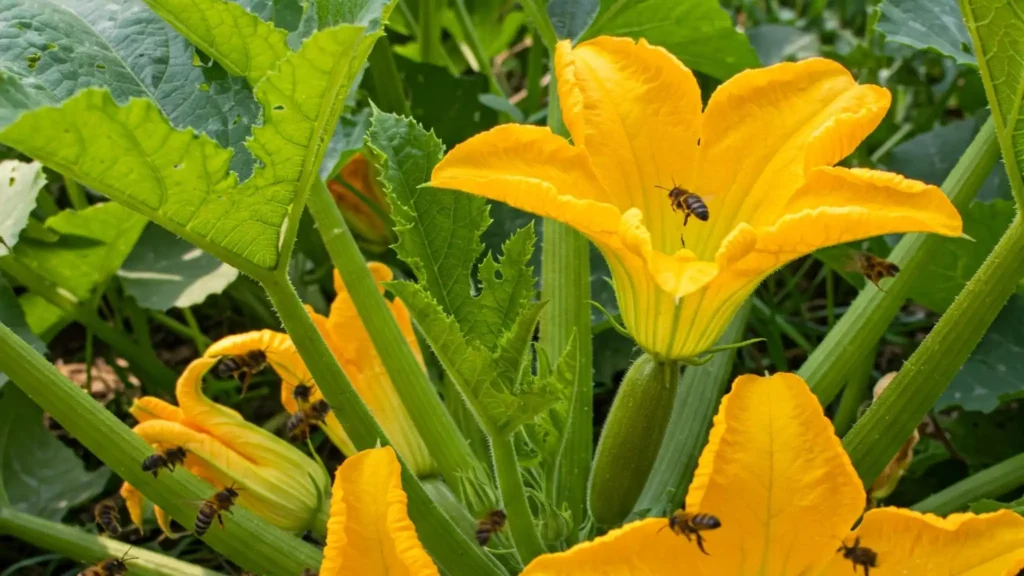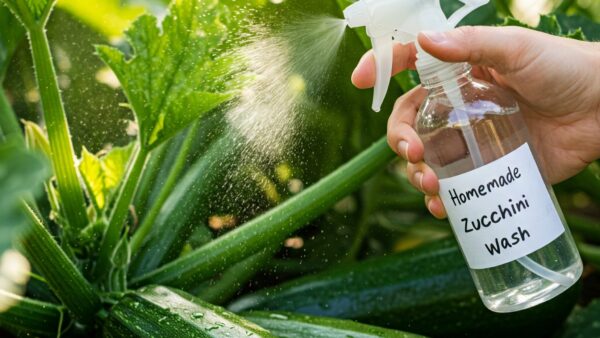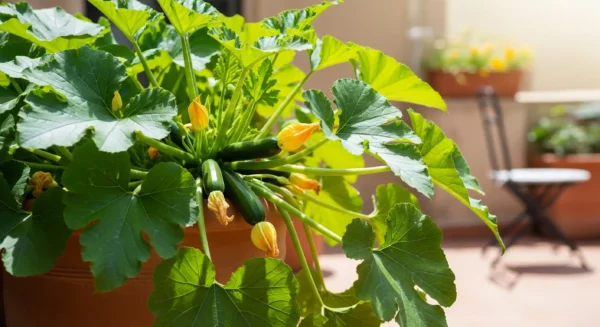Hand-Pollinating & Attracting Bees: Mastering Zucchini Pollination
Dreaming of the wonderful harvest to come, you watch with bated breath as those large, happy yellow flowers burst open. But then… no action follows. Perhaps little zucchinis begin to grow, only to wither and drop off the vine. What causes this? One of the most frequent questions for zucchini farmers is why there are flowers but no fruit.
Usually, the solution is one vital, sometimes ignored stage: pollination.
Though it may seem difficult, it’s really an interesting component of the magic of nature. To really generate the fruit we enjoy to eat, zucchini plants require some assistance moving pollen from one kind of flower to another. Sometimes nature takes care of this perfectly with busy bees; other times, however, things don’t quite match up and we end up fruitless and annoyed.
But no need to panic! This book aims to clarify zucchini pollination. We’ll look at why it’s important, teach you two important techniques to guarantee a plentiful harvest—becoming a “bee” yourself via hand-pollination and making your garden an alluring destination for natural pollinators—and show you precisely how to spot the various flowers involved. Want to know the key to zucchini success? Let’s start pollinating!
Zucchini Flower Power: Knowing Male vs. Female
Knowing that your plant generates two separate kinds of flowers—male and female—helps one to grasp zucchini pollination. Zucchini plants are monoecious, or one plant has both male and female components just on different flowers. Pollen must travel from a male flower to a female flower for a zucchini fruit to develop.
How then do you distinguish them? Once you know what to search for, it’s simpler than you believe!
- Meet the Male Flower: These guys often appear first, sometimes a week or so before the females do, which can create early confusion! Search for a flower perched on a long, thin, straight stem. Looking within the blossom will reveal the stamen, which resembles a fused cluster of stalks covered in powdery yellow pollen. Consider the male flower as the pollen supplier; its work is finished once the pollen is released, hence they naturally drop off after around one day.
- Meet the Female Flower: If you want fruit, the female flower is the genuine star! The dead giveaway is what’s behind the blossom: at the base of the flower you’ll see a little, obvious bulge. The ovary is this small bulge; if it gets pollinated, it will grow into a zucchini. Inside the female flower, you will find the stigma, usually multi-lobed and rather knobby or fuzzy; this is the area requiring pollen reception.
Why Both Count: No zucchini without pollen transfer! Pollen from a male flower will cause the female flower’s ovary to swell and mature into a full-sized fruit. Without pollination, the female flower will open, close, and the little ovary will probably turn yellow, wither, and drop off the plant.
The Pollination Problem: Why No Fruit Setting?
You see both male and female blooms; thus, why aren’t you producing zucchini? Many things can disrupt this vital pollen movement:
- Where Have the Bees Gone? Not Enough Pollinators: The main workers for zucchini pollination are bees; bumblebees and squash bees are especially excellent squash pollinators. Pollination will not occur if they are not present or not active during your flowers’ opening. Low bee activity is caused by:
- Bad Weather: On chilly, rainy, or very windy days, bees are less active. A badly timed rainy spell can greatly interfere with pollination since zucchini flowers are usually only fully open for a few hours in the morning.
- Pesticides: Spraying broad-spectrum insecticides in or near your garden can kill or harm bees as well as other helpful pollinators.
- Habitat Loss: A general lack of varied flowers and nesting sites in the surrounding area can result in lower total pollinator numbers.
- Bad Timing (Flower Mismatch): Occasionally, the plant simply gets its timing a little wrong.
- Early Season: All Males, No Females: Zucchini plants often generate a wave of only male flowers first before the females start showing. Have patience!
- All Women, No Men: Less frequent, but occasionally the opposite occurs momentarily.
- Pollination requires both male and female flowers open at the same time. Timing is important since most flowers only survive one day, opening in the morning and closing by the afternoon.
- Environmental Stress: Occasionally, extreme circumstances matter. Extreme temperatures, extended drought, or serious nutrient shortages could affect pollen generation, flower viability, or pollinator activity.
Playing Cupid: Hand-Pollinating Zucchini Like a Pro
Should you think bad pollination is to blame for your zucchini shortage, relax! Hand-pollination lets you quickly step in and play matchmaker yourself. Surprisingly, it’s rather easy, fast, and nearly guarantees fruit set if done properly. It’s also somewhat enjoyable—like you’re actually involved in the life cycle of the plant!
Why hand-pollinate? It guarantees that pollen travels where it has to go, therefore overcoming problems including poor weather or low bee populations. It lets you manage the output of fruit.
Best Time to Act: Here, timing is also quite important! Early in the morning, just after the flowers have opened (typically between 6 AM and 10 AM), is the ideal time to hand-pollinate. At this time, the pollen is most plentiful and viable, and the female stigma is most responsive. By the afternoon, flowers usually close up.
Your Guide in Steps:
- Set Your Goals: Find a newly opened female flower (with the little zucchini bulge behind it) and a newly opened male flower (on its thin stem, pollen visible inside). You require both to be open on the same day.
- Gather the Pollen: The Flower (Method 1): Select a male flower from the plant with care. Gently remove its yellow petals to completely reveal the stamen covered with pollen in the center.
- Bring the Pollen: Quickly carry your petal-less male flower to an open female flower. Find the fuzzy/bumpy stigma in the middle of the female blossom. Directly onto the female stigma, gently but thoroughly dab or brush the pollen from the male stamen. Ensure you have decent coverage! Often, one male flower will pollinate multiple female flowers.
- Collect & Deliver (Method 2: The Tool): You could also use your fingertip, a cotton swab, or a tiny, soft artist’s paintbrush. To collect the yellow pollen, softly swirl it inside the male flower; then, brush or dab that pollen onto the stigma of the female flower. Every pollination session calls for a clean instrument.
That’s all! Really, it’s that simple. Once pollinated, the female flower will shut later in the day. Should pollination be successful, you should observe that little zucchini (the ovary) behind the flower begin to swell and grow quite visible in only a few days. Pollination probably didn’t take if it yellows and shrinks.
Inviting the Experts: Drawing Bees to Your Garden
Although hand-pollination is a wonderful alternative, allowing nature’s experts—the bees!—to do the work is even better. Designing a bee-friendly garden helps to attract these necessary pollinators to your zucchini patch on a regular basis.
- Plant a Pollinator Buffet: Relying only on zucchini flowers is unwise. Near your squash patch, plant a mix of other flowers that bees enjoy. Gardens with several food sources draw bees. Among the excellent options are:
- Herbs: Thyme, sage, mint, lavender, borage (a squash bee favorite!).
- Flowers: Asters, coneflowers, goldenrod, alyssum, zinnias, cosmos, bee balm (Monarda), sunflowers. Aim to have something flowering all season long. Different forms of flowers draw various kinds of bees.
- Provide a Bee Bath: On warm days, bees also require water. Offer a shallow dish of water and put corks, marbles, or pebbles in it. This offers them safe landing and drinking spots free from drowning. Maintain cleanliness and replenishment.
- Forget the Strong Chemicals! This is quite important. Especially neonicotinoids, which are very harmful to bees, avoid using broad-spectrum pesticides. Should you have to address a pest issue, pick late in the evening or very early morning to apply focused organic treatments such as insecticidal soap for aphids or Bt for caterpillars, when bees are not actively foraging. Read labels closely!
- Embrace a Little Wildness: Especially early in the season, think about allowing some “weeds” like clover or dandelions flourish in areas of your lawn. When other flowers could be limited, they offer beneficial food for bees. Sometimes a well-kept lawn is not the most bee-friendly setting.
Creating a welcoming environment in your garden helps to greatly improve the likelihood that bees will locate your zucchini flowers and perform the pollination for you.
No Fruit Yet? Resolving Ongoing Problems
You see bees, you’ve attempted hand-pollinating, yet those tiny zucchinis continue to wither? Though rarer, if pollination appears to be successful but fruit does not grow, think about these options:
- Extreme Stress: Occasionally, very high heat (consistently over 90-95°F or 32-35°C), severe drought, or significant nutrient imbalances will cause the plant to abort even pollinated fruit to save resources. Guarantee regular feeding and watering.
- Disease: Though usually other symptoms like leaf spots or wilting would also be present, some diseases could possibly influence fruit development.
Should pollination issues continue, examine the general health of your plant and its growing circumstances.
Conclusion: Guaranteeing Your Zucchini Bounty
It’s thrilling to see those first zucchini flowers; the true pleasure comes from watching those flowers develop into tasty squash. Solving most “no fruit” issues depends on knowing the straightforward mechanics of zucchini pollination: the need of pollen to move from a separate male flower to a female flower with that tell-tale little zucchini behind it.
You now have the means to guarantee pollination whether you decide to be a temporary “bee” yourself with hand-pollination (a fast and simple morning chore!) or concentrate on building a buzzing paradise to draw natural pollinators by planting bee-friendly flowers and forgoing dangerous pesticides. Mastering this vital stage will help you to enjoy the plentiful zucchini crop you were wishing for, which can even be too much. Enjoy your gardening and pollinating!
Frequently Asked Questions
How long does it take for zucchini to produce fruit?
Typically, you can expect to start harvesting zucchini about 50 to 60 days after planting the seeds, depending on the variety and growing conditions. Flowering usually begins a bit before that.
How do you make zucchini produce more fruit?
To encourage more fruit, harvest zucchini regularly when they are young (6-8 inches). This signals the plant to keep producing. Ensure good pollination by attracting bees or hand-pollinating. Also, provide ideal growing conditions: full sun, consistent watering, and rich, well-drained soil with adequate nutrients.
Why are my zucchini plants flowering but no fruit?
This is almost always due to a lack of pollination. Reasons include: not enough bees (due to weather, pesticides, or lack of habitat), male and female flowers not being open at the same time (especially early on when only male flowers might be present), or extreme environmental stress (heat, drought) affecting flowers or pollinators.
How long after flowering do zucchini appear?
If a female flower is successfully pollinated, the tiny zucchini (ovary) at its base will start to swell noticeably within just a few days. Growth is rapid after that, often reaching harvestable size in another 4 to 8 days depending on conditions










